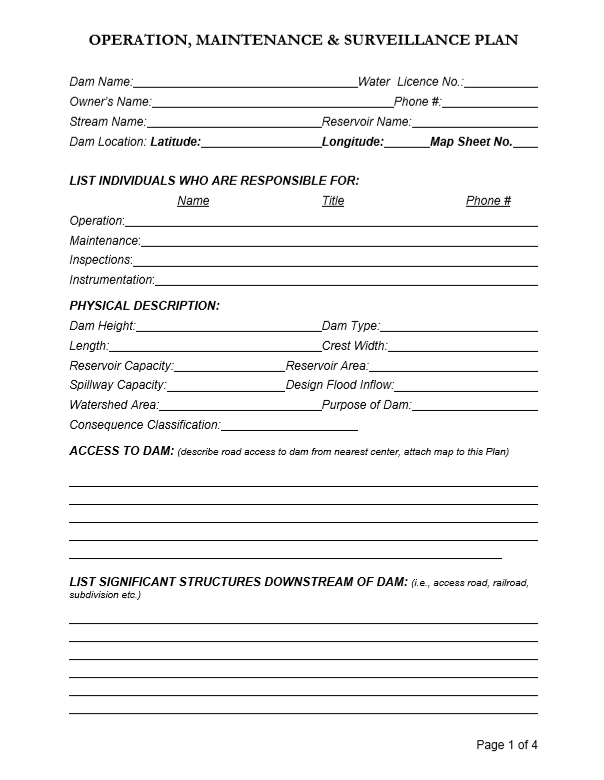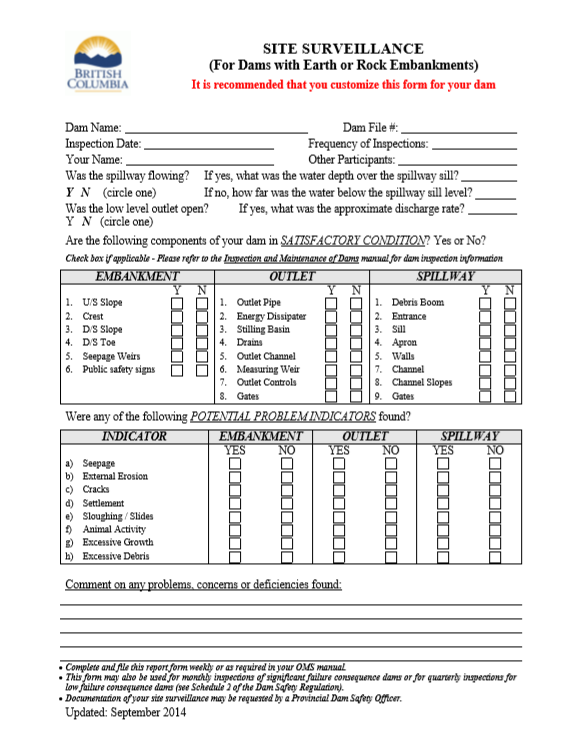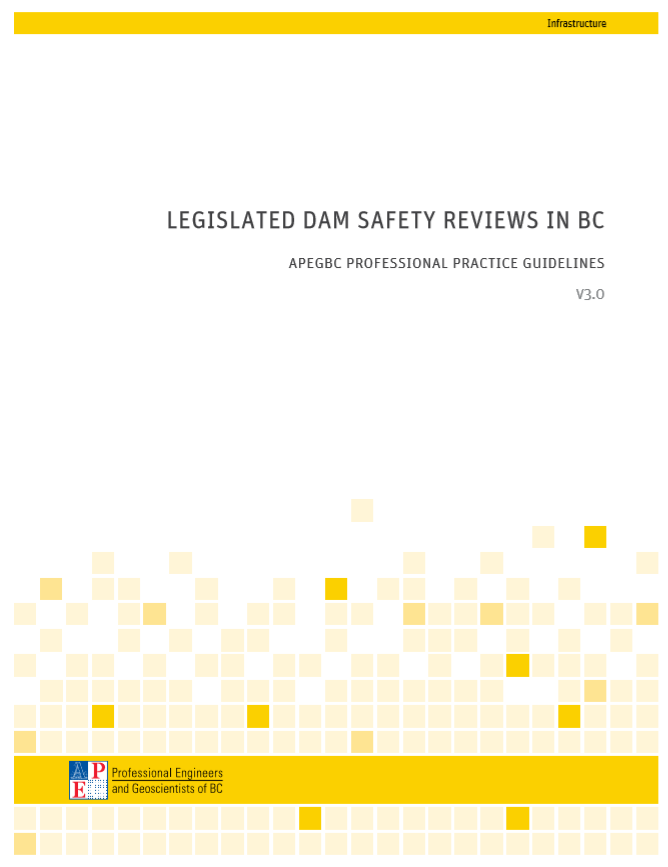Module 5: Regulations and Documentation
This module will provide an overview of the documentation, policies, and governing laws that relate to dam safety in British Columbia. The information provided here will cover the very basics of the fundamental aspects discussed.
It is highly recommended that you visit and review the URL links provided for each section, such that you fully understand the content below.
Clicking each link will open the new page or document in a new window.
Water Sustainability Act
The Water Sustainability Act (WSA) was brought into effect on February 29, 2016 to ensure a sustainable supply of fresh, clean water that meets the needs of B.C. residents today and in the future. It is the principal law for managing the diversion and use of water resources. The WSA provides important new tools and updates B.C.'s strategy for protecting, managing, and using water efficiently throughout the province.
The WSA introduces a number of changes to the way that water is managed in B.C. such as:
- Licensing groundwater for non-domestic use
- New fees and rentals for water use
- Stronger protection for aquatic ecosystems
- Expanding protection of groundwater related to well construction and maintenance
- Increasing dam safety and awareness
Dam Safety Regulations
More than 1,500 active dams in B.C. are regulated under the Water Sustainability Act. Regulated dams require a water licence issued under the Act and must meet the requirements specified in the Dam Safety Regulation.
There are procedures and practices that are important to know if you're involved in the management, design, construction, rehabilitation, decommissioning, or removal of dams in B.C.
The Dam Safety Regulation sets requirements and best practices for all aspects of dam design, construction, operation, maintenance, removal, and decommissioning. These regulations came into effect on February 29, 2016, replacing the former B.C. Dam Safety Regulation (2000).
The Dam Safety Regulation defines a dam as a barrier constructed for the purpose of enabling the storage or diversion of water from a stream or an aquifer, or both, plus any other works incidental to or necessary for the barrier.
The Regulation is composed of five parts. A diagram of the five parts is also depicted below:
Part 1 provides definitions and interpretations; describes application of the Regulation to minor dams that are less than 7.5 m high and store 10,000 m3 or less of water, which may be exempt from the Regulation.
Part 2 sets requirements that apply to all other dams, except those which are exempt.
Part 3 sets additional requirements for specific dams, including those:
- 1 m in height and capable of impounding a total storage volume of water greater than 1,000,000 m3
- 2.5 m or more in height and capable of impounding a total storage volume of water greater than 30,000 m3
- 7.5 m or more in height, regardless of the amount of water able to be stored
- Dams with a failure consequence classification of significant, high, very high or extreme
Part 4 includes general provisions and offences applicable to all regulated dams.
Part 5 provides the transition periods for phasing out old requirements and phasing in new requirements.
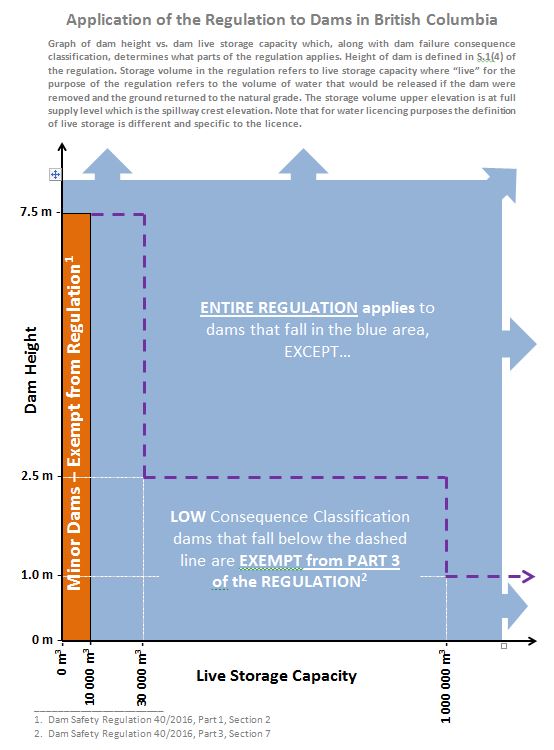
Schedules 1 & 2
Within the dam safety regulations are Schedules 1 and 2. These tables identify:
- key requirements based on consequence classification for dam owners to follow
- minimum required activities set forth in legislation
Schedule 1 below outlines consequence classification based on a worst case dam failure scenario. The consequence classification of a dam is based on three factors:
- Loss of life
- Environmental and Cultural loss
- Infrastructure and Economic loss
Schedule 1
|
Dam failure |
Population |
Consequences of failure |
||
|
Loss of life |
Environmental and |
Infrastructure |
||
|
low |
none |
no possibility of loss of life other than through unforeseeable misadventure |
minimal short-term loss or deterioration and no long-term loss or deterioration of |
minimal economic losses mostly limited to the dam owner's property, with virtually no pre-existing potential for development within the dam inundation zone |
|
significant |
temporary only |
low potential for multiple loss of life |
no significant loss or deterioration of |
low economic losses affecting limited infrastructure and residential buildings, public transportation or services or commercial facilities, or some destruction of or damage to locations used occasionally and irregularly for temporary purposes |
|
high |
permanent |
10 or fewer |
significant loss or deterioration of |
high economic losses affecting infrastructure, public transportation or services or commercial facilities, or some destruction of or some severe damage to scattered residential buildings |
|
very high |
permanent |
100 or fewer |
significant loss or deterioration of |
very high economic losses affecting important infrastructure, public transportation or services or commercial facilities, or some destruction of or some severe damage to residential areas |
|
extreme |
permanent |
more than 100 |
major loss or deterioration of |
extremely high economic losses affecting critical infrastructure, public transportation or services or commercial facilities, or some destruction of or some severe damage to residential areas |
Schedule 2 below summarizes the minimum frequency of required activities, set under legislation. Dam owners who fail to show due diligence in complying with this schedule may be held liable for damages caused by one of their dams failing. The required activities for a dam is determined by consequence classification.
Schedule 2
|
Activity |
Frequency of Activity |
||||
|
Extreme |
Very high |
High |
Significant |
Low |
|
|
redetermine classification of dam and, if necessary submit to DSO written notice of proposed new classification |
annually |
annually |
annually |
annually |
annually |
|
conduct site surveillance |
weekly unless otherwise specified in the OMS manual |
weekly unless otherwise specified in the OMS manual |
weekly unless otherwise specified in the OMS manual |
monthly unless otherwise specified in the OMS manual |
quarterly |
|
conduct formal inspection |
semi-annually |
annually |
annually |
annually |
annually |
|
test operation of |
annually unless otherwise specified in the OMS manual |
annually unless otherwise specified in the OMS manual |
annually unless otherwise specified in the OMS manual |
annually unless otherwise specified in the OMS manual |
annually |
|
collect readings from instrumentation and analyze and interpret the readings |
annually unless otherwise specified in the OMS manual |
annually unless otherwise specified in the OMS manual |
annually unless otherwise specified in the OMS manual |
annually unless otherwise specified in the OMS manual |
if and when required by a dam safety officer |
|
review contact information in DEP, revise if necessary and report to DSO |
annually |
annually |
annually |
annually |
not applicable |
|
review emergency contact information and, if necessary, revise and submit revision to DSO |
not applicable |
not applicable |
not applicable |
not applicable |
annually |
|
review OMS manual and DEP, revise if necessary and report to DSO |
every 7 years |
every 7 years |
every 10 years |
every 10 years |
not applicable |
|
ensure dam safety review carried out and submit report to DSO |
every 7 years |
every 10 years |
every 10 years |
not applicable |
not applicable |
Operation, Maintenance, and Surveillance Manual/Plan
The objective in formulating an operation, maintenance and surveillance (OMS) plan is to provide the greatest possible assurance of dam safety and continuous operation of the reservoir.
An effective plan provides all the information and instruction needed to allow an inexperienced person to perform all actions required to operate the dam safely. In the case of an emergency, the OMS plan may provide information that can aid in the protection and/or notification to the public downstream.
Among the items that should be addressed are:
- the operation of the outlet gate and the spillway,
- the surveillance/inspection schedule of the dam,
- the monitoring of the dam’s performance,
- the recording and interpreting of inspection results,
- the development of a Dam Emergency Plan, and
- the performance of all required maintenance.
By creating and using an OMS plan, the dam owner can expect these benefits:
• Assuring the safety of the dam and the continuous operation of the reservoir,
• Minimizing the need for costly repairs,
• Extending the useful life of the structure
Site Surveillance and Formal Inspections
The purpose of a dam inspection program is to identify problems and/or unsafe conditions. Inspection is an integral part of a proper maintenance program for a dam. Failure to correctly identify and repair maintenance issues could result in the failure of a dam.
*Note that routine site surveillance is different from an annual formal inspection.
Site Surveillance
Performing site surveillance as part routine of maintenance is the most economical means of assuring the safety and prolonging the life of the structure. Instances of routine site surveillance are straightforward procedures where owners and/or inspectors can make an accurate assessment of a dam’s condition. This process involves careful examination of the surface on all parts of the structure.
Surveillance of the dam's components should be carried out appropriately, aligning with the dam’s consequence classification (see Schedule 2). Reduced frequencies of routine surveillance may need to be selected to suit seasonal conditions.
Any detection of changes should be measured and recorded. Reservoir level, operational conditions, outlet and spillway releases should also be recorded as this may give insight into any deficiencies found on the dam.
Formal Inspections
Formal inspections are intended to be a more thorough inspection performed by the appropriate representative of the owner. The frequency required for formal inspection and maintenance based on consequence classification can be found in Schedule 2 of the Dam Safety Regulation.
The formal inspection shall be recorded in a formal inspection report and kept by the dam owner as part of the historical record.
A more comprehensive inspection checklist “Formal Annual Inspection” is available on the dam safety website. Copies of these formal inspection reports may be requested by the Dam Safety Officer for audit.
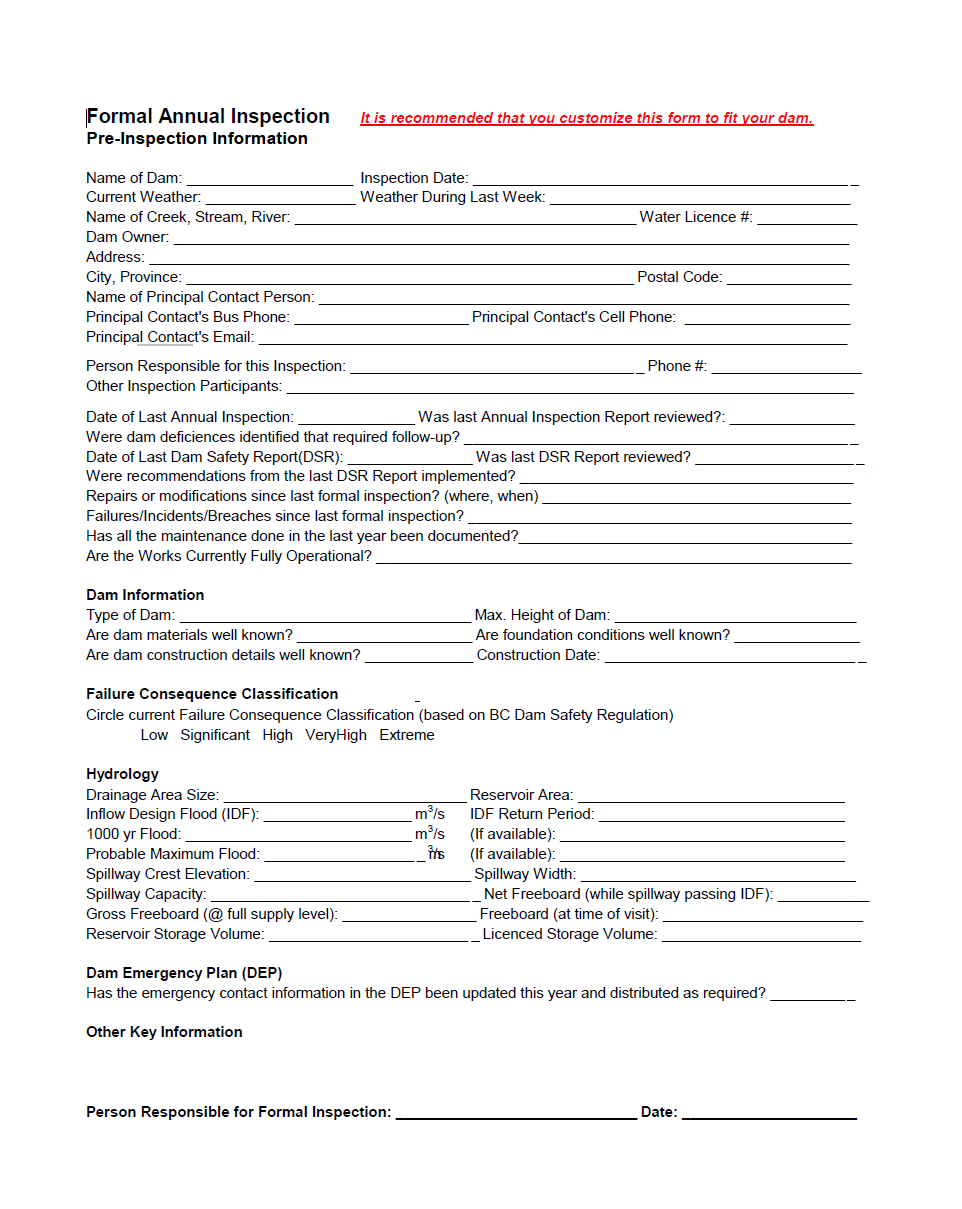
Key Considerations
For both the site surveillance and formal inspections, it is helpful to have a systemic method of inspection which can be repeated consistently. By organizing and listing the various components of a dam in an inspection report, a methodical approach for inspection can be easily developed. A review of notes, photographs and drawings from the previous inspections should precede the actual field inspection. This will allow comparison of the dam's present condition to a prior state.
The inspection itself should include all of the components of the dam. Any gates or control valves associated with the spillway and/or low level outlet should be inspected and tested if possible to ensure that they are operational. This includes a close examination of all accessible moving parts. The inlet and outlet structures should be inspected with close attention given to the internal condition of any conduit, pipes or access wells. Anything unusual or anything that has changed since the last inspection should be noted (i.e. new or increased erosion, settlement, cracks, seepage, or wet areas).
Photographs should be taken during the inspection. Many of the problems which a dam may develop do not happen over night but can take months or years to become obvious. By comparing photographs from previous inspections to the present, many of the subtle changes in a dam’s condition can be noted.
Dam Emergency Plan
The new regulation still requires dam owners to prepare an emergency plan, now called a Dam Emergency Plan (DEP). However there are some key changes including what they must contain, what must be done with them, and the date by which they must be prepared and submitted for acceptance by the Dam Safety Officer.
The Guide & Template for Preparing a Dam Emergency Plan (DEP) in British Columbia, is available on the dam safety website and has been adapted from the CDA guidelines and the Association of State Dam Safety Officials Emergency Action Planning Resource Center (ASDSO EAP) for use by dam owners in British Columbia to assist in the preparation of their mandatory Dam Emergency Plan. The DEP template is intended for smaller to mid-sized dams but could also be adapted to larger dams.
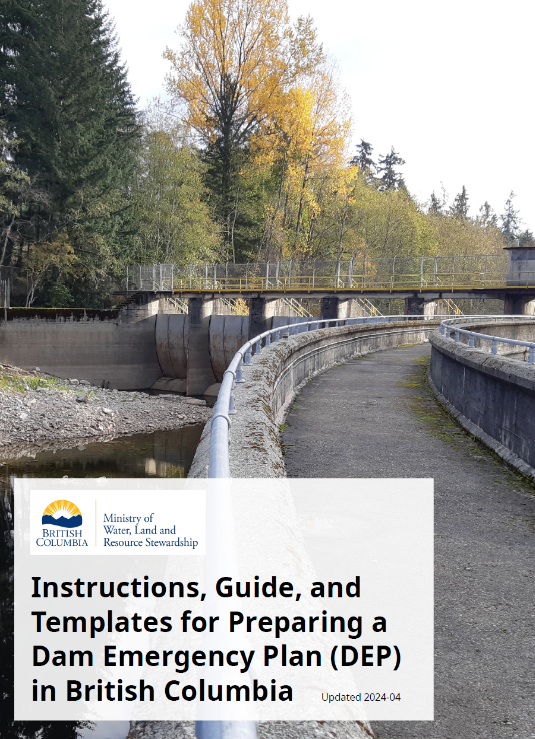
If a dam is designed according to sound engineering principles and is well constructed and maintained, the possibility of failure is extremely remote. However if a potential failure of a dam poses a hazard to life and property, the dam owner must have a Dam Emergency Plan to deal with any potential problems. This plan should address the following:
• Who will be affected and how can they be contacted? Persons immediately downstream should be notified as well as local authorities so they can co-ordinate evacuation plans if necessary.
• What can be done at the dam site to manage the situation and what equipment is needed and where can the equipment be found?
• Who else should be notified (i.e., Dam Safety Officer, Emergency Management and Climate Readiness (EMCR), police, local government, road authorities, etc.)?
• Is this information readily available and is it updated periodically?
A template for preparing a Dam Emergency Plan, is provided above and on the Dam Safety in BC website. Contact your Dam Safety Officer for more information.
Dam Safety Review
As per the Dam Safety Regulations - owners of high, very high and/or extreme failure consequence classification dams are required to complete a Dam Safety Review (DSR) every 7 to 10 years, as specified in Schedule 2 of the Regulation. A DSR is not required for significant and low consequence dams.
The objective of the DSR, prepared by a professional engineer with qualifications and experience in dam safety analysis, is to determine if the dam under review is 'reasonably safe' as per Section 20 of the Regulation. Dam safety reviews require a systematic review and evaluation of all aspects of the design, construction, maintenance, operation, processes and systems affecting a dam’s safety - including the dam safety management system.
The dam safety review involves the collection of all available dam records, field inspections and detailed assessments of the structural and hydraulic features of the dam. It then proceeds with a check of structural stability and operational safety of the dam, beginning with a reappraisal of basic features and design assumptions. The level of detail required in a Dam Safety Review should be proportional with the importance and complexity of the dam, as well as the consequences of failure. Refer to our technical resources page for more guidelines and information on dam safety reviews.
EGBC Guidelines
In July 2013, the Engineers and Geoscientists of BC (EGBC) published the Professional Practice Guidelines – Legislated Dam Safety Reviews. This document replaced the BC Dam Safety Review Guidelines (version 3 - Nov 2012).
The Guidelines assist in project organization, determination of responsibilities, and provides general principles governing dam safety analysis, quality assurance/quality control, and report presentation.
The guidelines are meant to assist and ensure the following:
Dam Owners
- Where to find a qualified professional
- What should be included in a Request for Proposal (RFP)
Qualified Professionals
- Minimum qualifications/experience required
- Dealing with significant information gaps
- Minimum requirements for a DSR report to be accepted by the regulator
- More guidance in dam safety analysis.
Qualified professional engineers may now add their name to EGBC's Discrete Scope Projects Directory based on self-declarations indicating they are qualified by training or experience to provide engineering support in the area of Dam Safety Analysis. This directory is available to the public.

